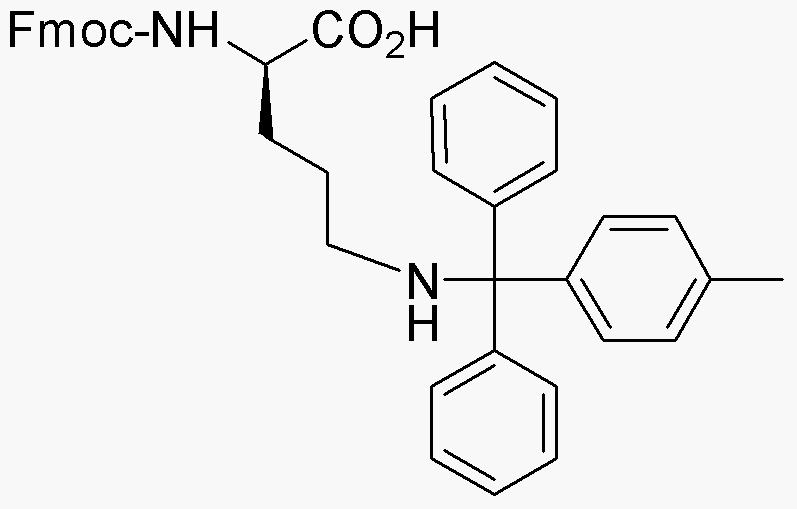Na-Fmoc-Nd-methyltrityl-D-Ornithine is widely utilized in research focused on:
- Peptide Synthesis: This compound serves as a key building block in the synthesis of peptides, particularly in solid-phase peptide synthesis. Its protective groups facilitate the stepwise addition of amino acids, ensuring high purity and yield.
- Drug Development: In pharmaceutical research, it is used to create peptide-based drugs. The ability to modify its structure allows researchers to design compounds with specific biological activities, enhancing therapeutic efficacy.
- Bioconjugation: The compound is employed in bioconjugation techniques, linking peptides to other biomolecules such as antibodies or enzymes. This application is crucial in developing targeted drug delivery systems.
- Research in Cancer Therapy: It has potential applications in cancer research, where modified peptides can be used to target cancer cells specifically, improving treatment outcomes while minimizing side effects.
- Protein Engineering: The compound is valuable in protein engineering, allowing scientists to create novel proteins with enhanced properties for various applications, including diagnostics and therapeutics.
General Information
Properties
Safety and Regulations
Applications
Na-Fmoc-Nd-methyltrityl-D-Ornithine is widely utilized in research focused on:
- Peptide Synthesis: This compound serves as a key building block in the synthesis of peptides, particularly in solid-phase peptide synthesis. Its protective groups facilitate the stepwise addition of amino acids, ensuring high purity and yield.
- Drug Development: In pharmaceutical research, it is used to create peptide-based drugs. The ability to modify its structure allows researchers to design compounds with specific biological activities, enhancing therapeutic efficacy.
- Bioconjugation: The compound is employed in bioconjugation techniques, linking peptides to other biomolecules such as antibodies or enzymes. This application is crucial in developing targeted drug delivery systems.
- Research in Cancer Therapy: It has potential applications in cancer research, where modified peptides can be used to target cancer cells specifically, improving treatment outcomes while minimizing side effects.
- Protein Engineering: The compound is valuable in protein engineering, allowing scientists to create novel proteins with enhanced properties for various applications, including diagnostics and therapeutics.
Documents
Safety Data Sheets (SDS)
The SDS provides comprehensive safety information on handling, storage, and disposal of the product.
Product Specification (PS)
The PS provides a comprehensive breakdown of the product’s properties, including chemical composition, physical state, purity, and storage requirements. It also details acceptable quality ranges and the product's intended applications.
Certificates of Analysis (COA)
Search for Certificates of Analysis (COA) by entering the products Lot Number. Lot and Batch Numbers can be found on a product’s label following the words ‘Lot’ or ‘Batch’.
*Catalog Number
*Lot Number
Certificates Of Origin (COO)
This COO confirms the country where the product was manufactured, and also details the materials and components used in it and whether it is derived from natural, synthetic, or other specific sources. This certificate may be required for customs, trade, and regulatory compliance.
*Catalog Number
*Lot Number
Safety Data Sheets (SDS)
The SDS provides comprehensive safety information on handling, storage, and disposal of the product.
DownloadProduct Specification (PS)
The PS provides a comprehensive breakdown of the product’s properties, including chemical composition, physical state, purity, and storage requirements. It also details acceptable quality ranges and the product's intended applications.
DownloadCertificates of Analysis (COA)
Search for Certificates of Analysis (COA) by entering the products Lot Number. Lot and Batch Numbers can be found on a product’s label following the words ‘Lot’ or ‘Batch’.
*Catalog Number
*Lot Number
Certificates Of Origin (COO)
This COO confirms the country where the product was manufactured, and also details the materials and components used in it and whether it is derived from natural, synthetic, or other specific sources. This certificate may be required for customs, trade, and regulatory compliance.


